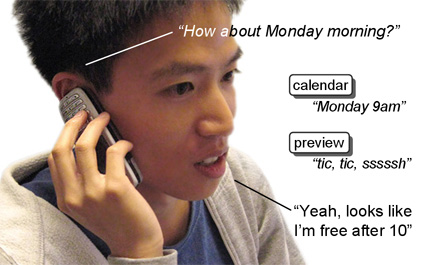|
|
|
up patrick baudisch |
blindsight |
microsoft research |
 |
To access phone information stored on the phone mid-conversation, users press buttons and receive auditory confirmation. This photo shows the flipPhone form factor. |
|
Get the
Flash Player to see this player.
|
Many mobile phones integrate services such as personal calendars. Given the social nature of the stored data, however, users often need to access such information as part of a phone conversation. In typical, non-headset use, this requires users to interrupt their conversations to look at the screen.
To address this problem, we propose eyes-free access to information stored on the phone. Our prototype application blindSight enables this via auditory feedback. This feedback is heard only by the user, not by the person on the other end of the line. Users control blindSight using the phone keypad while the phone is held up against the userís ear. We present the design of the blindSight system, which is designed to minimize interference between auditory feedback and phone conversation. We have implemented a prototype system on an Audiovox 5600 Smartphone.
We present the results of two user studies. The first study verifies that useful keypress accuracy can be obtained for the phone-at ear position. The second study compares the blindSight system against a visual baseline condition. It required participants to access their contact list and negotiate calendar appointments interactively and eyes-free while talking on the phone. Subjective results indicate a strong preference for blindSight over the visual baseline condition.
|
|
Li, K., Baudisch, P., and Hinckley,
K. |
This is a collaborative effort with Kevin Li during his summer internship at MSR, summer 2007